Recent Articles
Popular Makes
Body Types
2024 Hyundai Kona Road Test and Review
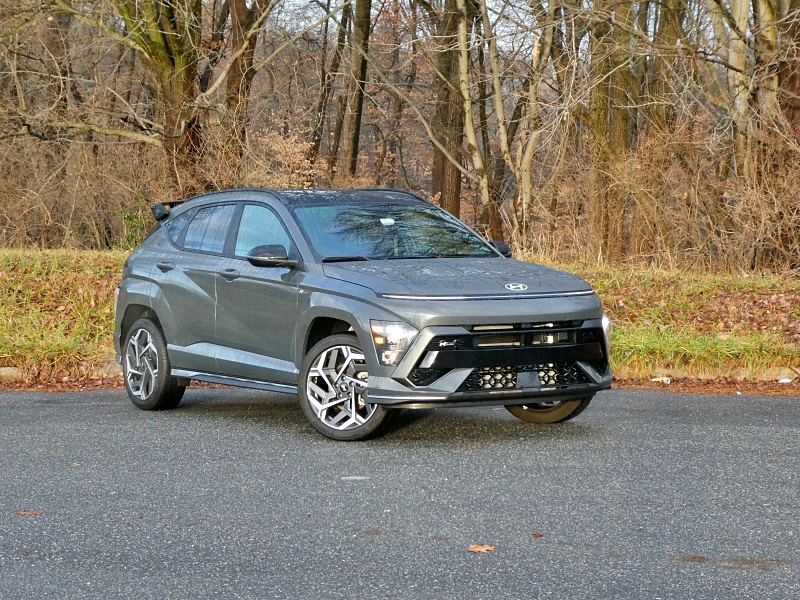
2024 Hyundai Kona N Line ・ Photo by Brady Holt
The 2018 Hyundai Kona arrived as automakers were still figuring out the idea of a subcompact crossover. The result was a zippy little SUV with funky styling, a bumpy ride, and a tight backseat and cargo area.
When it came time to redesign the Kona, Hyundai decided to keep pushing the stylistic envelope while chasing mainstream appeal in most other ways. The all-new 2024 Hyundai Kona is no longer small, bumpy, or especially zippy. For this review, we just spent a week testing the redesigned Kona. Keep reading as we discuss this small SUV’s pros and cons to see if it’s the right affordable crossover for you.
Priced From $24,250
The 2024 Hyundai Kona is priced from $24,250, which is about $2,000 more than last year’s model and about $4,000 more than it cost in 2018. Still, that’s not bad for a well-equipped crossover these days.
Even the base Kona SE includes a big 12.3-inch touchscreen infotainment system, 17-inch alloy wheels, push-button starting, automatic emergency braking, a lane-departure warning, and blind-spot monitoring. The SEL, $25,450, adds a power driver’s seat, automatic climate control, leather on the steering wheel and shift knob, and 18-inch wheels, along with the chance to order a $2,200 Convenience Package with a digital gauge cluster, wireless smartphone charger, GPS navigation, heated front seats, and adaptive cruise control. The $30,800 N Line, like our test vehicle, comes with the Convenience Package plus a more powerful engine, an eight-speaker Bose stereo, suede upholstery, 19-inch wheels, and performance-themed styling changes. The top Limited ($31,800), which we also drove briefly, has leatherette upholstery, ventilated front seats, a heated steering wheel, a power liftgate, a blind-spot parking camera, and a surround-view parking camera. All-wheel drive costs $1,500 on all trim levels. Overall, the Kona can get expensive, but it remains competitively priced.
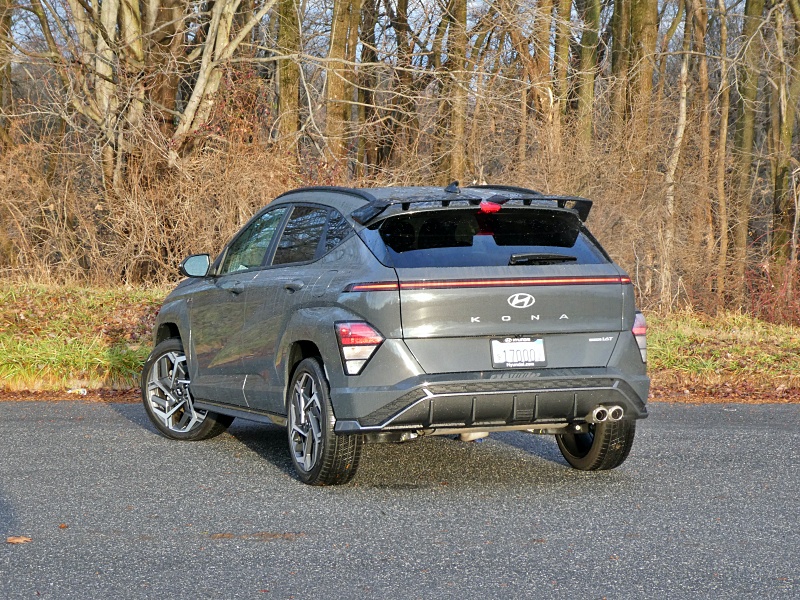
2024 Hyundai Kona N Line ・ Photo by Brady Holt
Wild New Styling
The Kona has always been an attention-getting crossover, with a pugnacious plastic-clad hot-hatch vibe. The 2024 model doesn’t try to blend in, either, especially in this pictured Limited model’s coat of Neoteric Yellow. (No, not Neurotic; we misread it at first, too.) Slim front and rear lightbars sit atop chunky lights carved out of the bumpers, which house the main headlamps and taillamps. The body and fenders are artfully creased. The N Line has a big spoiler at the top of its liftgate, while other models have black plastic fenders; the N Line also has the most aggressively bulging front bumper.
In a key difference from the Kona’s mechanical cousin, the boxy Kia Seltos, the Kona’s body leans forward like a hatchback, with the roofline dropping down toward the SUV’s rear. Another neat design cue is the four-cornered intersection of the side windows with the edge of the rear windshield. Critics may find the Kona too busy-looking, but others will appreciate it for not looking like other SUVs.
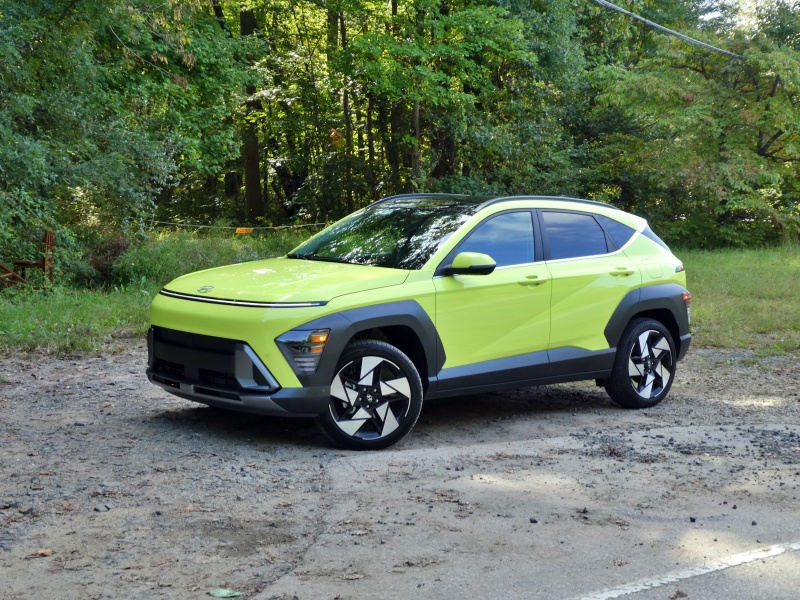
2024 Hyundai Kona Limited ・ Photo by Brady Holt
Higher-Tech Interior
In the time since its 2018 debut, the first-generation Kona picked up a fair bit of technology. Last year’s Kona was available with a pair of 10.25-inch screens (a digital gauge cluster plus an infotainment touchscreen), but they were retrofitted into a gently curved dashboard.
The 2024 Kona goes all-in on showing off its technology. A 12.3-inch touchscreen is standard on even the base model, and it’s attached to the digital gauge cluster for the appearance of a single screen spreading most of the way across the dash. The dashboard also got blockier in the redesign, with mostly straight lines. We appreciate how Hyundai keeps plenty of physical controls for simple functions rather than excessively relying on the touchscreen, though the screen itself proved fussy at certain things. For instance, to show the song playing on the radio, you have to travel through menus to summon a view that fills up the whole 12.3 inches. The interior finishes aren’t as upscale as a Honda HR-V’s, but the Kona’s digital dazzle is what you'll likely notice most.
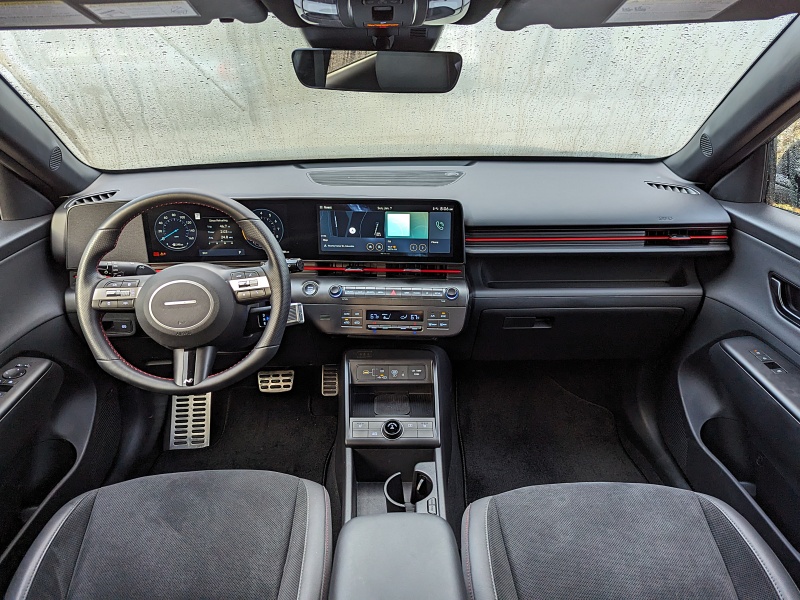
2024 Hyundai Kona N Line ・ Photo by Brady Holt
Bigger Backseat
Our biggest complaint about the old Kona was its interior room. It was fine when you were sitting up in the front – no problem for plenty of happy owners – but limited elsewhere. The 2024 Kona tackles that complaint in a big way, literally.
This is still a subcompact crossover, so don’t expect limo-like accommodations, but it now has room for adults to fit in both the front and the rear seats. All but the base SE include eight-way power adjustability for the driver’s seat; heated front seats are optional on the next-up SEL and standard on the rest of the lineup; and ventilated front seats are newly standard on the top Limited.
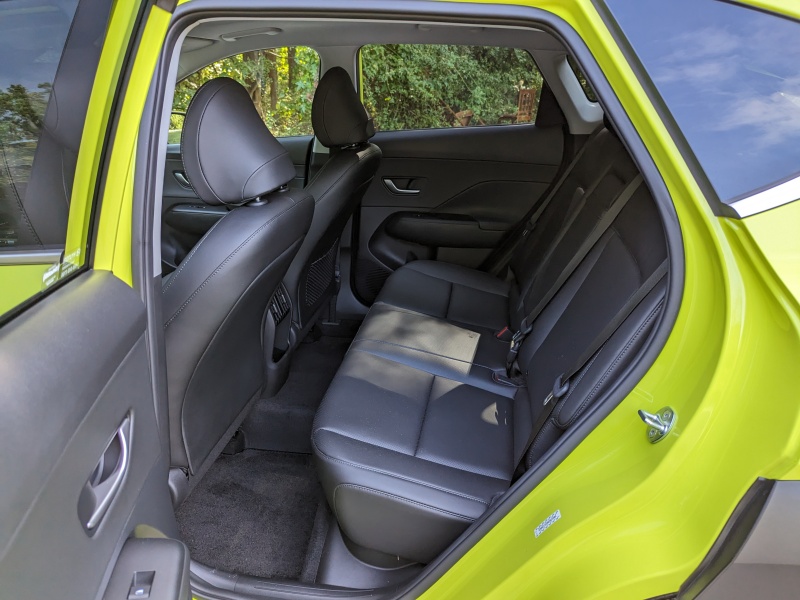
2024 Hyundai Kona Limited ・ Photo by Brady Holt
More Cargo Room, Too
Even if you don’t care about a big backseat, anyone can appreciate the Kona’s extra cargo space. Last year’s model had the cramped cargo hold of a small hatchback, while the 2024 has grown up into an SUV. Volume behind the rear seat grows from 19.2 cubic feet to 25.5 (a 33 percent improvement) while total volume is up 39 percent from 45.8 cubic feet to 63.7. These are among the best cargo capacities in the subcompact crossover segment.
Also, higher-end Konas like our test vehicles use a column-mounted gear selector to free up an open and reconfigurable center console area, including retractable cupholders that disappear when you want to drop your stuff between the seats rather than hold drinks. The SE and most SELs sacrifice some space to provide a console-mounted shifter. We do wish the center console armrest was covering an enclosed bin like in most cars, though. In the Kona, the space under the armrest is open in front, which means you can fit bulkier items easily, but nothing will be held in place or kept out of sight.
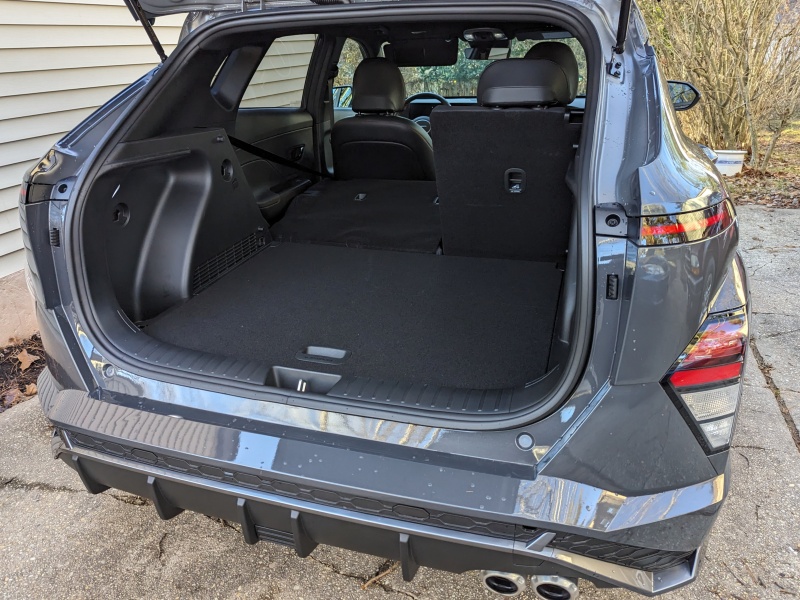
2024 Hyundai Kona N Line ・ Photo by Brady Holt
A Calmer Drive
The old Kona was a spunky little car, especially with one of its available turbocharged engines. Acceleration and handling were lively, and the top Kona N was a 276-horsepower performance monster. For better or for worse, the new Kona calms down. It still looks like a sporty SUV, particularly in N Line garb like our test vehicle, but its focus is a smooth ride and easy handling. The N is gone, and the Kona's growth spurt means the remaining engines deliver lazier acceleration than before.
The SE and SEL use a 2.0-liter four-cylinder sending a modest 147 horsepower and 132 lb-ft of torque through a continuously variable automatic transmission. The N Line and Limited use a 1.6-liter turbo with a more impressive-sounding 190 hp and 195 lb-ft of torque mated to an eight-speed conventional automatic. Hyundai scrapped the turbo’s old dual-clutch automatic that was known to occasionally fumble its shifts, but it was snappier than the new transmission when you were in a hurry. Combined with the Kona’s weight gain, the turbo drops from feisty to largely unobjectionable – humming you along at an acceptable, unexceptional pace. But it was alarmingly unresponsive when we tried to accelerate into a lane change; even in the selectable Sport mode, it repeatedly waited a beat or two before giving us power.
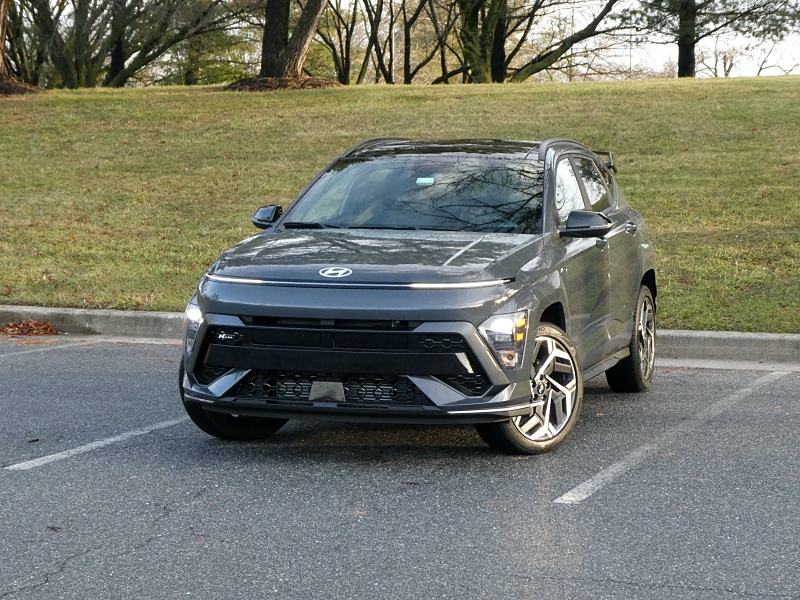
2024 Hyundai Kona N Line ・ Photo by Brady Holt
An Electric Option
The quickest 2024 Kona will surely be the Kona Electric. Priced from $32,675, it manages an EPA-estimated 200 miles per charge on the base SE and 261 miles on upper trim levels. And it gets the energy equivalent of 118 miles per gallon.
The gas-powered Konas are less impressive. The base 2.0-liter engine gets worse mileage than even last year’s turbo: 29 mpg in the city, 34 mpg on the highway, and 31 mpg combined with front-wheel drive and just 27 mpg city, 29 mpg highway, and 28 mpg combined with all-wheel drive. That’s not great for a less-than-speedy subcompact crossover. And the turbo falls to 26 mpg city, 32 mpg highway, and 28 mpg combined with front-wheel drive and 24 city, 29 highway, and 26 combined with AWD. Our test vehicle did even worse, managing just 25 mpg in a weeklong test.
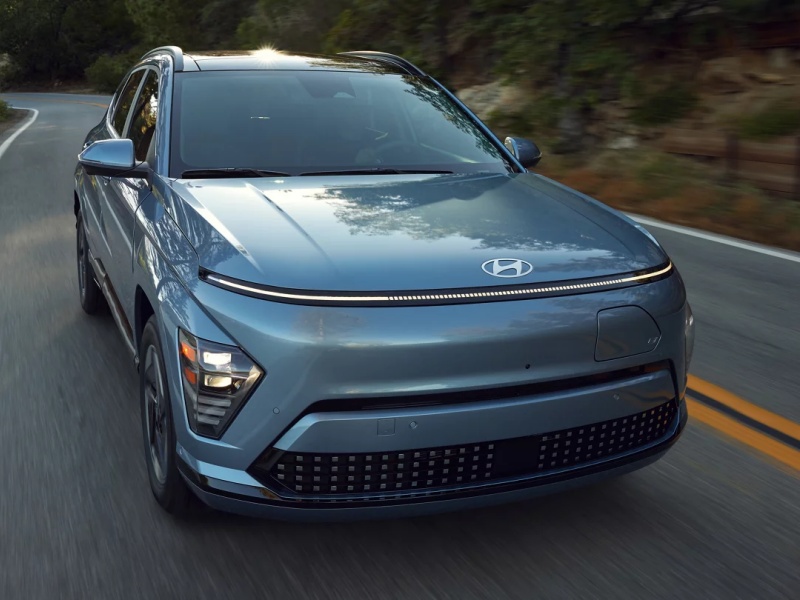
2024 Hyundai Kona Electric ・ Photo by Hyundai
Competitors to Consider
As a newly roomy subcompact crossover, the Kona’s leading competitors are the Honda HR-V, Subaru Crosstrek, and its own Kia Seltos cousin.
The HR-V is a spacious, polished, sophisticated little vehicle with crisply composed ride and handling, an elegantly finished cabin, and an even lower starting price than the Kona. But if you’re looking to stand out, the subdued Honda has the opposite of Hyundai’s stylistic exuberance and spiffy in-dash technology. The rugged, capable, yet comfortable Crosstrek is also less high-tech than the Kona. The Subaru also doesn’t have as much cargo room and can get expensive if you want certain features. The Seltos brings familiar Kona strengths and weaknesses for a bit less money. The main differences are that the Kia is less flashy inside and out, and that a lighter weight makes it slightly quicker. Meanwhile, if you liked the old Kona for its sportier performance, you might consider the Mazda CX-30 or all-wheel-drive versions of the Volkswagen Taos. However, the Mazda doesn’t match the new Kona’s spaciousness, the Taos is more expensive, and neither matches the Hyundai’s big infotainment display.
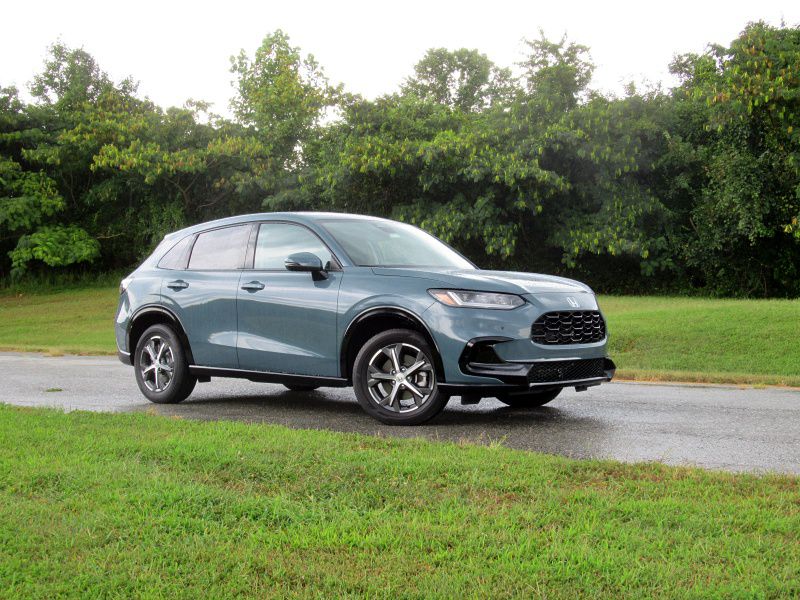
2023 Honda HR-V ・ Photo by Brady Holt
Funky-Looking Maturity
Fans of the old Kona might lament that the new model is less special than before. It’s still uniquely styled, but it’s no longer a winner for sporty driving pleasure, especially if you’re attached to the Kona N.
But if you liked the Kona for its funky looks but craved a smoother ride, more space, and a technological upgrade, the 2024 model is a winner. More to the point, Hyundai has broadened the Kona’s appeal to a wide swath of the subcompact crossover market. Competition abounds, but the Kona now has something for just about everyone – except those who want their little SUV to be faster and more agile.
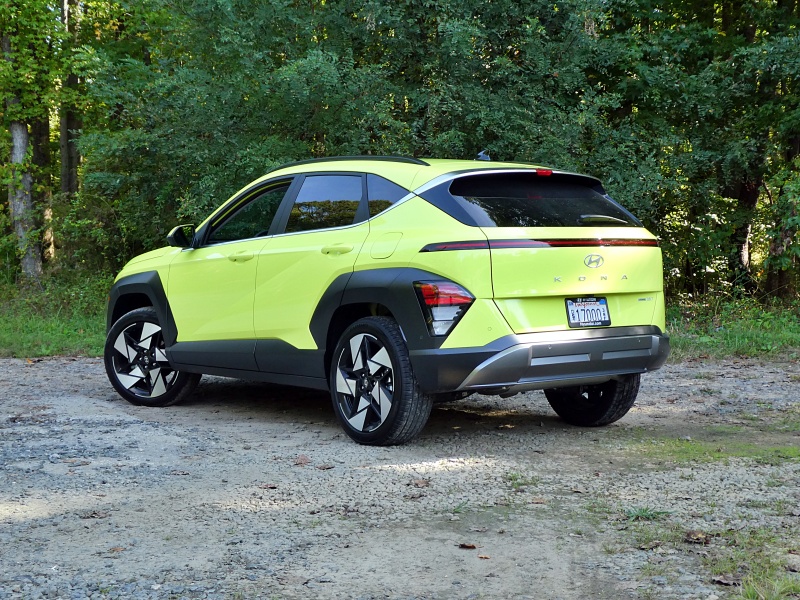
2024 Hyundai Kona Limited ・ Photo by Brady Holt